Learning About Sapphires
Sapphires: Composition, Formation, and Origins
Sapphires belong to the corundum family, a mineral species that also includes rubies. The key difference between these two gems lies in their color: while rubies are red, sapphires can come in a wide array of colors, with blue being the most iconic. The name “sapphire” is most commonly associated with the blue variety, but sapphires also occur in pink, yellow, green, orange, purple, and even colorless forms. Non-blue sapphires are often referred to as “fancy sapphires.”
Chemical Composition and Crystal Structure
Chemically, sapphires are composed of aluminum oxide (Al₂O₃). What gives sapphires their stunning colors are trace elements that become incorporated into the crystal structure during formation. For example:
Blue sapphires owe their color to the presence of iron and titanium.
Pink sapphires contain traces of chromium.
Yellow and green sapphires are influenced by a combination of iron and other elements.
Sapphires have a trigonal crystal system, forming hexagonal prismatic crystals. They are exceptionally hard, ranking 9 on the Mohs scale—just below diamonds—making them suitable for daily wear in all types of jewelry.
Formation of Sapphires
Sapphires form under intense pressure and high temperatures deep within the Earth’s crust, typically in areas with significant geological activity. The process begins with the cooling and solidification of magma, which allows aluminum and oxygen to bond and create the crystalline structure of corundum. When trace elements like iron or chromium are present during this process, they influence the resulting color of the sapphire.
Over millions of years, geological forces such as erosion and tectonic movement can bring these gems closer to the Earth’s surface, where they can be mined.
Where Are Sapphires Found?
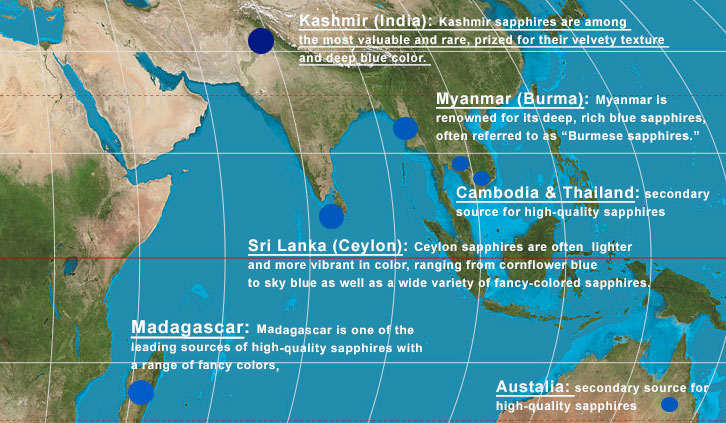
The world’s most prestigious sapphires come from a few key regions, each known for producing stones with distinct qualities:
Sri Lanka (Ceylon): Sri Lanka has a long history of producing some of the world’s most beautiful sapphires. Ceylon sapphires are often lighter and more vibrant in color, ranging from cornflower blue to sky blue. The island also produces a wide variety of fancy-colored sapphires.
Myanmar (Burma): Myanmar is renowned for its deep, rich blue sapphires, often referred to as “Burmese sapphires.” These stones are known for their intense saturation and silk-like luster.
Kashmir (India): Kashmir sapphires are among the most valuable and rare, prized for their velvety texture and deep blue color. Mining in this region is extremely limited, making these sapphires exceptionally rare and highly sought after by collectors.
Madagascar: In recent years, Madagascar has emerged as one of the leading sources of high-quality sapphires. Sapphires from Madagascar can display a range of colors, with blue, pink, and yellow being the most common.
Other notable sources include Australia, Thailand, and Cambodia, each producing sapphires with unique color characteristics and qualities.
Different Colors of Sapphires
Blue Sapphires
Hue and Quality: The deep blue sapphire is renowned for its rich, intense color, which can range from vibrant cornflower blue to royal blue. The most prized blue sapphires exhibit a pure blue hue with minimal secondary color tones. The depth and saturation of the blue color are key factors in determining the value of these stones.
Sources: Famous blue sapphires are sourced from regions like Kashmir, Myanmar (Burma), Sri Lanka, and Madagascar. Each location imparts distinct qualities to the sapphires, contributing to their unique appearances.
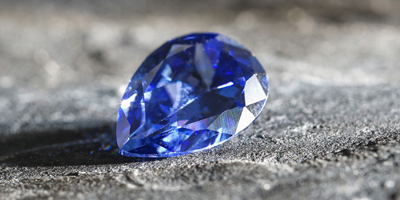
Pink Sapphires
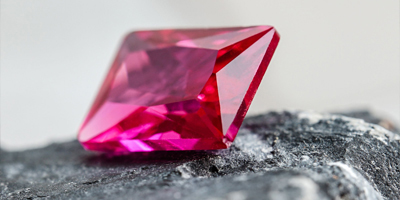
Yellow Sapphires
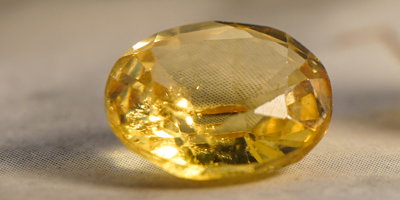
Green Sapphires
Hue and Quality: Green sapphires come in a spectrum from light green to a more intense, forest green. The most valuable green sapphires have a deep, rich green color with good saturation. They often display a pleasing balance of brightness and depth.
Sources: Significant sources of green sapphires are Sri Lanka, Madagascar, and Australia. The green color in these sapphires is due to the presence of trace elements such as iron.
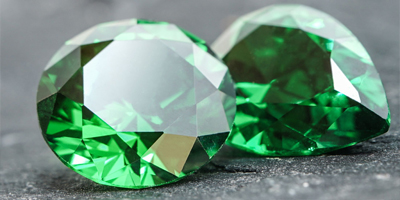
Orange Sapphires
Hue and Quality: Orange sapphires can range from a pale, pastel orange to a vivid, intense tangerine color. The most valuable orange sapphires are those with a bright, lively orange hue and high saturation, often referred to as “padparadscha” sapphires.
Sources: Notable sources include Sri Lanka and Madagascar. Padparadscha sapphires, which are a unique blend of orange and pink, are particularly rare and valuable.
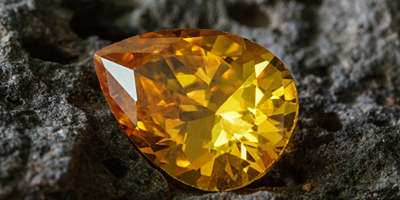
Purple Sapphires
Hue and Quality: Purple sapphires range from light lavender to deep, rich purple. The most prized purple sapphires have a strong, vivid purple hue with good saturation. These stones are valued for their deep, royal appearance.
Sources: Purple sapphires are found in Sri Lanka, Myanmar, and Madagascar. The presence of trace elements like chromium and iron gives these sapphires their distinctive color.

Colorless Sapphires
Hue and Quality: Colorless sapphires, often called “white sapphires,” can be a beautiful alternative to diamonds. They are valued for their clarity and brilliance, with a transparent appearance that allows for a sparkle similar to that of diamonds.
Sources: Colorless sapphires can be sourced from several locations, including Sri Lanka and Madagascar. They are often used in jewelry as a more affordable option to diamonds.
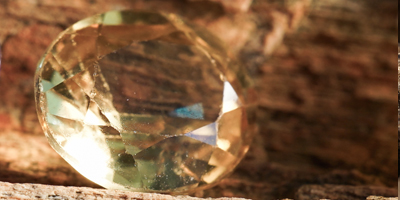
Impact of Color on Sapphire Value
The value of a sapphire is significantly influenced by its color, with deep blue sapphires generally commanding the highest prices. Several factors contribute to how color impacts the value of a sapphire:
Hue: The term “hue” to the sapphire’s dominant color. For blue sapphires, the ideal hue is a pure blue. However, many sapphires have secondary hues, such as violet, purple, or green. A slight violet secondary hue is generally acceptable, and even desirable in some cases, as it can enhance the stone’s overall vibrancy. Greenish-blue or grayish -blue sapphires, on the other hand, are typically less valued
Saturation: Saturation refers to the intensity or vividness of the sapphire’s color. High-quality sapphires have strong saturation, with vivid and vibrant color. Too little saturation makes the stone appear dull or washed out, while excessive saturation can make it look inky or overly dark. The best sapphires have a rich, balanced saturation that enhances their beauty without overpowering the gem’s natural sparkle.
Tone: Tone refers to how light or dark the sapphire appears. The ideal tone is medium to medium-dark, which means the stone has a deep, rich color without being too dark or too light. Sapphires that are too light may look pale, while those that are too dark can appear almost black, losing their brilliance and sparkle.
Color Consistency: Evenness of color across the gemstone also affects its value. A sapphire with a uniform color distribution is more valuable than one with color zoning or unevenness.
Origin: While not directly related to color, the origin of the sapphire can influence its value. Sapphires from renowned sources like Kashmir, Myanmar, and Sri Lanka are often valued higher due to their historical significance and the unique qualities associated with these regions.
The combination of hue, saturation, tone, and color consistency helps to define the worth of a sapphire, with the most prized stones exhibiting a deep, vibrant color that has captivated admirers for centuries.
Understanding Sapphire Value: Natural, Treated, and Synthetic Comparisons
The value of sapphires is largely determined by their natural status and the type of treatments they have undergone. Untreated natural sapphires are typically the most valuable due to their rarity and the fact that they have remained in their original, unaltered state. These gems are highly prized for their authenticity and the natural conditions under which they formed, which contribute to their exceptional allure and uniqueness.
Following untreated natural sapphires in terms of value are those that have undergone minimal enhancements. Heat treatment is the most common and widely accepted enhancement, which improves the color and clarity of the sapphire without altering its fundamental properties. Although heat-treated sapphires are less valuable than their untreated counterparts, they are still considered natural gemstones and retain significant worth, especially if the enhancement is well-executed and the stone’s quality is high.
In contrast, sapphires that have undergone more significant or artificial treatments tend to be less valuable. Treatments such as diffusion, which introduces color into the surface layers, or laser drilling, which creates channels to remove inclusions, can greatly impact the stone’s value. These treatments can alter the sapphire’s appearance and structural integrity, leading to a reduction in market value. Similarly, treatments that involve the addition of external substances, such as fracture filling or surface coatings, can compromise the gemstone’s natural status and desirability.
Synthetic sapphires, which are created in a laboratory and possess the same physical and chemical properties as natural sapphires, usually have the lowest value in the sapphire market. Despite their high quality and the ability to mimic the appearance of natural sapphires, synthetic stones lack the natural formation history that adds to the allure and value of genuine sapphires. Their lab-created nature and the controlled environment in which they are produced result in a significantly lower price point compared to natural gemstones.
Overall, the hierarchy of sapphire values reflects the balance between natural authenticity and the impact of various treatments. Untreated natural sapphires command the highest prices, followed by those with minimal enhancements. As treatments become more invasive or artificial, the value of the sapphire decreases, with synthetic sapphires typically being the least expensive due to their artificial origins.
Heat Treatment
Color Enhancement
Heat treatment involves subjecting sapphires to high temperatures in a controlled environment. This process can enhance or modify the color and clarity of the stones. The treatment typically takes place in a furnace at temperatures ranging from 800 to 1,800 degrees Celsius (1,472 to 3,272 degrees Fahrenheit), depending on the desired outcome.
Blue Sapphires: Heat treatment is commonly used to intensify the blue color of sapphires, often bringing out a more vivid, uniform hue. It can improve the overall color saturation and remove undesirable secondary tones, such as gray or green.
Fancy Colors: For sapphires of colors other than blue, heat treatment can enhance the richness of the hue. For example, pink sapphires can achieve a more vibrant pink, while yellow sapphires can develop a deeper golden tone.
Clarity Improvement
Heat treatment can also help to improve the clarity of sapphires by reducing the visibility of inclusions and internal flaws. This is achieved by melting and repositioning internal gas bubbles or other imperfections within the gemstone.
Impact on Value and Marketability:
Value
Enhanced Value: Sapphires that have undergone heat treatment typically have higher market values compared to untreated sapphires of similar quality. This is because the treatment improves the gemstone’s appearance, making it more desirable to buyers.
Acceptance
Heat-treated sapphires are widely accepted in the market. Most sapphires sold today are heat-treated, and the treatment is considered a standard practice. As a result, heat-treated sapphires are readily available and popular among consumers.
Higher Demand
Due to their enhanced color and clarity, heat-treated sapphires are often more sought after by buyers. The ability to achieve a more vibrant and uniform appearance increases their appeal.
Heat treatment is a prevalent and accepted practice in the sapphire industry, enhancing the color and clarity of these gemstones and increasing their marketability. While it can improve the appearance of sapphires, affecting their value, it is crucial for buyers to be informed about any treatments a sapphire has undergone. Understanding the treatment history helps in making educated purchasing decisions and ensures transparency in the market.
Other Treatments
Fracture Filling
This involves filling cracks or fractures in the sapphire with a glass-like substance to improve clarity. While this can enhance the appearance, it may impact the sapphire’s long-term durability and market value.
Impact on Natural Status
Alteration: This treatment introduces an external substance into the sapphire, altering its natural state.
Classification: Sapphires with fracture filling are not considered fully natural because the treatment involves modifying the gemstone by adding materials.
Diffusion Treatment
This process introduces color into the surface layers of a sapphire through a chemical reaction. Diffused sapphires are generally less valuable than heat-treated sapphires because the color is not evenly distributed throughout the gemstone.
Impact on Natural Status
Alteration: The color is primarily introduced into the surface layers, which changes the natural appearance of the sapphire.
Classification: Sapphires treated by diffusion are not considered fully natural because the treatment involves altering the surface characteristics of the gemstone.
Beryllium Treatment
Beryllium treatment uses beryllium to alter the color of sapphires, often producing vibrant hues such as intense yellow, orange, or pink.
Impact on Natural Status
Alteration: This treatment changes the natural color of the sapphire by introducing an external element (beryllium).
Classification: Beryllium-treated sapphires are not classified as fully natural due to the significant alteration of the gemstone’s color through an artificial process.
Laser Drilling
Laser drilling involves using a laser to create tiny channels in a sapphire to remove inclusions or improve clarity.
Impact on Natural Status
Alteration: This treatment involves physically altering the gemstone by creating channels and possibly filling them with substances to improve clarity.
Classification: Sapphires with laser drilling are not considered fully natural due to the modification of the stone’s internal structure.
Surface Coating
Surface coating involves applying a thin layer of material, such as a metallic coating, to the sapphire to enhance its color or appearance.
Impact on Natural Status
Alteration: This treatment modifies the natural surface of the sapphire by applying an external layer.
Classification: Sapphires with surface coatings are not regarded as fully natural because the treatment involves adding material to the gemstone.
Fracture Filling, Diffusion Treatment, Beryllium Treatment, Laser Drilling, and Surface Coating all significantly alter the natural state of sapphires by introducing external materials or modifying the gemstone’s internal and surface characteristics. These treatments make the sapphire different from its original, unaltered form, impacting its classification as a natural gemstone.
Heat Treatment and High-Pressure High-Temperature (HPHT) Treatment are generally accepted as natural enhancements because they improve color and clarity without adding external materials, thereby preserving the gemstone’s natural essence.
Sapphire Cuts and Shapes
When selecting a sapphire, the cut and shape of the gemstone play a critical role in its overall beauty, color, and brilliance. Unlike diamonds, which are typically standardized in cut and shape, sapphires are cut in a variety of ways to maximize their color and clarity. Here’s an overview of the most popular cuts and shapes for sapphires and how they enhance the gem’s appearance:
Popular Cuts and Shapes for Sapphires
Oval Cut
Description: The oval cut is one of the most popular shapes for sapphires due to its versatility and classic elegance. It offers a large surface area, which showcases the gemstone’s color beautifully while retaining good brilliance.
Advantages: The elongated shape can make the stone appear larger than it actually is, making it a popular choice for engagement rings and statement pieces.
Cushion Cut
Description: Cushion-cut sapphires feature a square or rectangular shape with rounded corners, resembling a pillow. This cut has been a timeless favorite due to its vintage appeal and the way it softens the gemstone’s overall appearance.
Advantages: Cushion cuts are ideal for sapphires because they often enhance color saturation, making the gem’s hue appear richer and deeper. The facets are arranged to balance color and brilliance, highlighting the stone’s natural beauty.
Round Cut
Description: The round brilliant cut, with its symmetrical shape and 58 facets, is popular for its exceptional sparkle and brilliance. Though less common for sapphires than for diamonds, round cuts are still a classic choice.
Advantages: The round cut maximizes brilliance and light reflection, making it ideal for sapphires with excellent clarity and color. It’s particularly suitable for lighter-colored sapphires, as it enhances their brightness.
Emerald Cut
Description: The emerald cut features a rectangular shape with long, linear facets arranged in a step-cut pattern. It emphasizes clarity and color over brilliance, offering a sophisticated and understated look.
Advantages: This cut is ideal for sapphires with deep, rich colors, as it showcases the gem’s natural hue and clarity. It provides a large “window” into the stone, making it a popular choice for those who value the gem’s color purity.
Princess Cut
Description: The princess cut is a square or rectangular cut with sharp, pointed corners and multiple facets designed to enhance brilliance. It’s a contemporary and versatile shape, perfect for modern jewelry designs.
Advantages: The princess cut offers both brilliance and color depth, making it a good choice for sapphires with vivid colors. The multiple facets help to reflect light and enhance the gemstone’s sparkle.
Pear Cut
Description: Pear-shaped sapphires have a teardrop silhouette, combining the elegance of a round cut with the elongation of an oval cut. The pear cut is often used in pendants and earrings, as well as unique engagement rings.
Advantages: The pointed tip and rounded base can create an illusion of greater size, and the shape can enhance the depth of color in the sapphire. The cut is especially attractive in settings that emphasize the stone’s distinctive shape.
Marquise Cut
Description: The marquise cut is an elongated shape with pointed ends, resembling a boat. It’s a more unusual choice for sapphires but can create a dramatic and eye-catching look.
Advantages: The marquise shape can make a sapphire appear larger and longer, and it’s particularly striking for gemstones with intense, even color.
How Different Cuts Enhance Sapphire Color and Brilliance
The way a sapphire is cut can significantly influence how it displays color and reflects light. Since sapphires are primarily valued for their color, cutters focus on maximizing the gemstone’s hue while balancing brilliance and clarity. Here’s how different cuts impact these qualities:
Color Enhancement
The depth of the cut plays a crucial role in enhancing or dulling a sapphire’s color. A deeper cut can intensify a gemstone’s hue, while a shallower cut may lighten the color. For example, cushion and oval cuts are often chosen for darker sapphires to balance and enhance their color saturation.
Facets are strategically placed to ensure that light enters the sapphire in a way that brings out its best color. Cuts with larger facets, like the emerald cut, are chosen for sapphires with excellent natural color, as they showcase the hue with less emphasis on sparkle.
Brilliance and Sparkle
Round and princess cuts are optimized for brilliance, with multiple facets designed to reflect the maximum amount of light. These cuts work well for sapphires that need more brightness or sparkle, especially lighter-colored stones.
Step cuts, like the emerald cut, emphasize clarity and color over sparkle, making them ideal for sapphires with deep, even hues. The long, linear facets allow light to travel through the stone more uniformly, highlighting its color intensity.
Maximizing Size Appearance
Cuts like the marquise, pear, and oval can make sapphires appear larger due to their elongated shapes. This is particularly beneficial for enhancing the visual impact of smaller stones or those with lighter colors.
Key Questions to Consider Before Buying a Sapphire
When purchasing a high-quality sapphire, it’s important to consider the following essential questions.
Color: The most important factor for sapphire quality. Look for a vivid, intense blue (or another desired color) with even saturation. Avoid stones that appear too dark or too light. Ask to receive a a summary of the sapphire’s color, including its hue, saturation, and tone? Specifically, to know if there are any secondary hues and how vivid the color saturation is, and whether the tone is balanced or if it appears too light or too dark
Clarity: Sapphires typically have inclusions, but you want one that is “eye-clean,” meaning no inclusions are visible to the naked eye. Ask about the clarity and whether any inclusions will affect the beauty or durability.
Cut: Since you want a perfect oval, ensure the stone is well-proportioned and symmetrical. Ask if the stone has been precision-cut for maximum brilliance.
Treatment: Many sapphires are heat-treated to enhance color. Ask if the sapphire is untreated or if it has undergone treatment, as untreated stones tend to be more valuable.
Origin: Some origins, like Kashmir, Burma, or Sri Lanka, are associated with high-quality sapphires. Ask about the stone’s provenance.
Certification: Request a certification from a reputable gemological lab (e.g., GIA or AGS) to ensure authenticity and quality. Ask about what certificate you will receive with the sapphire.
DiamondsAntwerp.com
- sales +32 473 21 02 44
- sales +32 473 21 02 44
- SUPPORT@diamondsantwerp.com
- NV JOAILLERIE FRÈRES FROHMANN, Pelikaanstraat 54, 2018 Antwerp, Belgium
